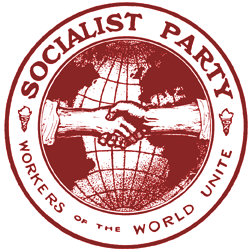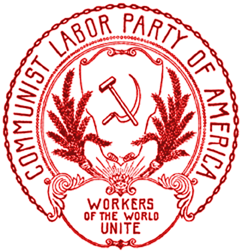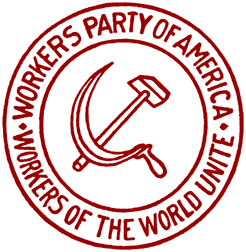Scandinavian Language Federations history
SCANDINAVIAN FEDERATIONS
Early Scandinavian Press
In the late 1890s, the Socialist Labor Party recognized a Danish-language newspaper, published in Chicago and called the Arbejderen, as an official party organ. This paper was repudiated by the New York regular party officials during the factional war of 1899, however, and died not long thereafter.
Scandinavian Socialist Federation
1. Founding Convention — Chicago, July 2-4, 1910.
The Scandinavian Socialist Federation was founded at a convention held in Chicago from July 2-4, 1910. By the turning of the New Year the federation counted 216 members in 7 branches.
The Scandinavian Federation began to maintain a benevolent association for its members in 1913, paying out sickness benefits.
In 1915 the Scandinavian Federation established its own printing plant. It subsequently distributed socialist literature of its own manufacture as well as imported titles.
In 1916 the Scandinavian Federation was split into six active districts with headquarters in the following cities: Duluth, MN; Kenosha, WI; Rockford, IL; Pittsburgh, PA; New York, NY; and West Concord, NH. At that time the Federation included a paid membership of 1,161 in 51 branches, About one quarter of the organization was female.
[fn: “The Scandinavian Socialist Federation”in The American Labor Year-Book, 1916. (NY: Rand School Press, 1916), pp. 141-142.]
Scandinavian Federation of the Communist Labor Party
Following the split of the Socialist Party of America in 1919, the Scandinavian Socialist Federation withdrew from the organization.
N. Juel Christensen, Translator-Secretary of the Scandinavian Federation during its affiliation with the SPA, joined the Communist Labor Party.
The Federation conducted a referendum of its branches in the Fall of 1919 to determine future affiliation.
[fn: Minutes of the CEC of the CPA, Nov. 15, 1919. Comintern Archive: f. 515, op. 1, d. 7, l. 8.]
Swedish group of the United Communist Party of America
There was only 1 primary party unit of the United Communist Party that spoke Swedish. It was located in the Seattle district.
[fn: DoJ/BoI Investigative Files, NARA M-1085, reel 940, doc. 501 — downloadable below.]
Scandinavian
Socialist Labor Federation [Swedish affiliate of the Socialist
Labor Party]
X. National
Convention — [city?], [date?], 1919
The Scandinavian Socialist Labor Federation held a convention in 1919, at which is was racked by division. The Federation reelected A.H. Lyzell as editor of its official organ, Arbetaren. The SLP’s 15th Convention, held in May 1920, overturned this decision, however, due to Lyzell’s outspoken support of former Weekly People editor Emil Seidel. A loyalist named Thor Borg was placed in the role of editor of the Federation’s newspaper.
Y. Special Convention — Boston, MA, July 3 - ?, 1920
The Lyzell faction held a special convention at Boston, MA, on July 3, 1920, and attempted to galvanize its forces. In response, the entire Federation was expelled and “reorganized”by the National Executive Committee of the Socialist Labor Party, a massive purge which reduced the size and strength of the de facto Swedish Federation to around 200 — an average of 168 monthly dues stamps sold in 1923. The expelled group — echoing the so-called Kangaroos of 1899 — attempted to organize using the same name and producing its own edition of Arbetaren, making use of the regular subscription list. The Regular SLP responded with a law suit, subsequently dropped. In the aftermath, the Scandinavian SLF found itself in severe financial difficulty, forced to reduce the size of its newspaper and to borrow money from the Bulgarian Socialist Labor Federation to make ends meet.
The regular party was not charitable in victory, with National Secretary Arnold Petersen declaring in his 1924 report of the NEC to the 16th National Convention that “The expelled faction of the Scandinavian Federation resorted to evey conceivable method to disrupt the Party, or at least the Scandinavian SLP Federation. It seems to be the law of disruption that when an SLP member goes wrong he goes to the utterrmost extreme limit in reviling the Party and outbidding the enemies of the Party in their attempts at breaking up the organization which therefore he had professed such undying faith in. Of course it may be said that such indiviudals, acting as they did, were not fit material for the Party.... Unfortunately, however, these individuals succeed in swaying otherwise honest though sentimental members, and though these may realize later that they were in the wrong, they seem to lack the manhood and courage to acknowledge their error, preferring to sulk in their respective corners."
[fn: C.A. Forsberg: “Scandinavian Federation”in 16th National Convention, Socialist Labor Party, May 10-13, 1924: Minutes, Reports, Resolutions, Platform, Etc., pp. 25-26; 87-90.]
Despite its multi-national name, the Scandinavian Socialist Labor Federation was effectively a Swedish-language organization, publishing translated material in Swedish as well as distributing literature purchased from publishing houses in Sweden. Following the 1920 organizational split it published its Swedish weekly newspaper, Arbetaren [The Worker], out of the SLP’s New York office. The paper was ostensibly published by the “Skandinaviska Socialistiska Arbetareförbundet.”In printed advertising the publication’s date of origin was dubiously post-dated back to the 1894 Danish SLP publication of the same name.
]fn. Advertisement for Arbetaren in Facklan: Svensk Almanack, 1921.]
United Scandinavian Socialist Federation
In 1922, the Scandinavian Socialist Labor Federation of the SLP united with the Scandinavian Socialist Federation to form the United Scandinavian Socialist Federation.
The United Scandinavian Socialist Federation conducted a referendum vote of its members, closing on Nov. 1, 1922, in which it voted to affiliate with the Workers Party of America..
[fn. Comintern Archive, f. 515, op. 1, d. 147, l. 84.]
Downloads
1908
MAY
“Report of Committee on Foreign Speaking Organizations to the National Convention of the Socialist Party, May 17, 1908.” Committee report to the 1908 SPA Convention in Chicago, delivered by S.A. Knopfnagel. The Committee advocated the acceptance of all foreign language organizations seeking affiliation with the Socialist Party, subject to 5 conditions: “(1) They are composed of Socialist Party members only. (2) Any foreign speaking organization having a national form of organization of its own be recognized only if all the branches composing this organization having been chartered by the national, state, or local Socialist Party organizations, and pay their dues to the respective Socialist Party organizations. (3) No foreign speaking organization asking the Socialist Party for recognition shall issue their own particular national, state, or local charters. Same to be issued only by the respective organizations of the Socialist Party, as the case may require. (4) All foreign speaking organizations affiliated with the Socialist Party must and shall conform in every respect with the Socialist Party national, state, and local constitutions, platforms, and resolutions. (5) They should function only as agitation, education, and organization bureaus of the Socialist Party.”Includes an amendment made from the floor but not published in the SP’s Official Bulletin (probably due to incompetence rather than malice) prohibiting the refusal of admission to the SPA on account of race or language.
1912
MAY
“Report of Scandinavian Section to the Socialist Party National Convention, May 1912” by N. Juel Christensen. Christiensen, the first Translator-Secretary of the Scandinavian Socialist Federation, outlines the group’s short history from its establishment in Chicago at a July 2-4, 1910, convention to its current status with 30 branches and “over 1,000”members. The Scandinavian Socialist Federation owned and published two weekly newspapers, The Svenska Socialisten [Swedish] and The Social Demokraten [Danish]. The group was particularly strong in the midwest, facing competition with the established SLP Scandinavian organization in the East and a largely unorganized Scandinavian population in the West, Christensen notes.
DECEMBER
“United Communist Party — “Groups" According to Language: As of December 1920.” This is based upon an internal document of the United Communist Party captured by the Department of Justice’s Bureau of Investigation in the April 1921 raid on UCP National Headquarters in New York. The UCP prided itself on having largely eliminated the federation-based form of organization which typified its rival, the Communist Party of America. Groups (Primary Party Units of between 5 and 10 members) were nevertheless based around language as well as geography and statistics tabulated by the organization. This snapshot from the midpoint of the UCP’s one year of existence surprisingly shows more South Slavic (Croatian and Slovenian) language groups than any other (144), followed by the Russian (136), English (121), German (61), Latvian (49), Yiddish (37), Lithuanian (34), and Finnish (31) language groups.
1923
undetermined date
“Membership Series by Language Federation for the Workers Party of America. ‘Dues Actually Paid’ — January to December 1923.” Official 1923 data set of the Workers Party of America, compiled from a document in the Comintern Archive. This series shows a great numerical dominance of the WPA by its Finnish Federation, accounting for a massive 42.8% of the average monthly paid membership of the organization (6,583 of 15,395). The total of the English language branches is the 2nd strongest amongst the federations (7.6%) followed by the South Slavic (7.5%), Jewish [Yiddish language] (6.9%), and Lithuanian (6.0%) Federations. In all, there were statistics kept for 18 different language groups of the WPA in 1923, including the English and the barely organized Armenian sections.
“Initiation Stamps Sold by Federation for the Workers Party of America. January to December 1923.” Official 1923 data set of the Workers Party of America, compiled from a document in the Comintern Archive. This series once again (repeating the previous published 1924 series) shows a schizophrenic pattern of stamp sales among language groups . Some federations clearly did not collect the initiation fees called for in the WPA constitution at all (Jewish, German, Latvian) while at the same time the quantities sold via the English branches are ridiculously high. Over 53% of the initiation stamps sold for the entire WPA were credited to the English branches — nearly three times as many initiations than there were average duespayers in those English branches! Even assuming a significantly higher than average “membership churn”rate for English branches, there is clearly some other unexplained phenomenon at play in these English branch initiation stamp sale figures...
1924
undetermined date
MAY
Undetermined Month




